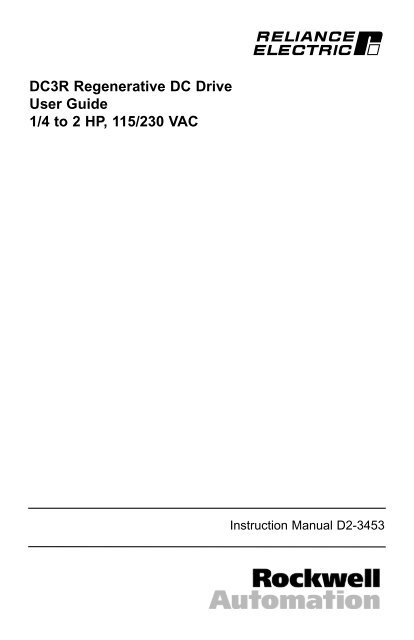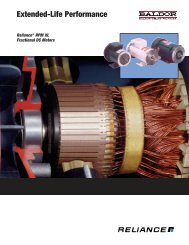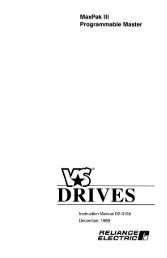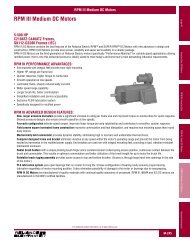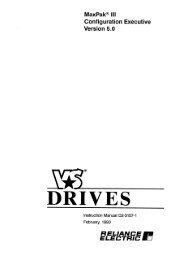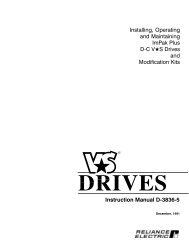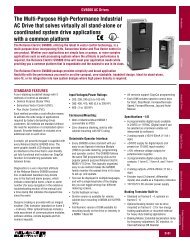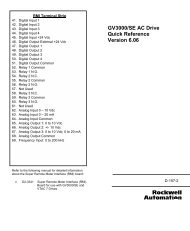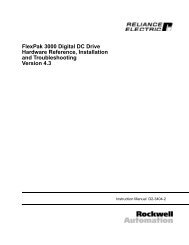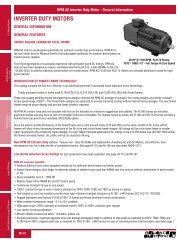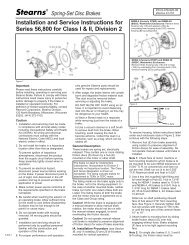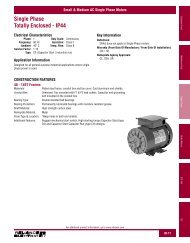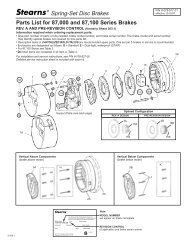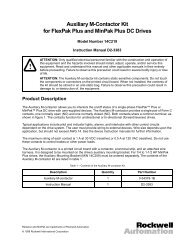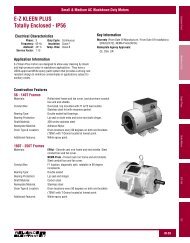DC3R Regenerative DC Drive User Guide 1/4 to ... - Reliance Electric
DC3R Regenerative DC Drive User Guide 1/4 to ... - Reliance Electric
DC3R Regenerative DC Drive User Guide 1/4 to ... - Reliance Electric
You also want an ePaper? Increase the reach of your titles
YUMPU automatically turns print PDFs into web optimized ePapers that Google loves.
The information in this manual is subject <strong>to</strong> change without notice.Throughout this manual, the following notes are used <strong>to</strong> alert you <strong>to</strong> safetyconsiderations:ATTENTION: Identifies information about practices or circumstancesthat can lead <strong>to</strong> personal injury or death, property damage, or economicloss.IMPORTANT: Identifies information that is critical for successful application andunderstanding of the product.ATTENTION: The control circuit is at line potential when the drive isenergized. Use a non-metallic screwdriver when making adjustments <strong>to</strong>the circuit board potentiometers. Exercise extreme caution ashazardous voltage exists. Failure <strong>to</strong> observe these precautions couldresult in severe bodily injury of loss of life.ATTENTION: Only qualified personnel familiar with the construction andoperation of this equipment and the hazards involved should install,adjust, operate, and/or service this equipment. Read and understandthis instruction manual in its entirety before proceeding. Failure <strong>to</strong>observe this precaution could result in severe bodily injury or loss of life.ATTENTION: The user is responsible for conforming with all applicablelocal and national codes. Failure <strong>to</strong> observe this precaution could resultin severe bodily injury or loss of life.ATTENTION: It is possible for a drive <strong>to</strong> run at full speed as a result of acomponent failure. Please ensure that a master switch has been placedin the AC line <strong>to</strong> s<strong>to</strong>p the drive in an emergency.ATTENTION: Reduce the chance of an electrical fire, shock, orexplosion by proper grounding, over-current protection, thermalprotection and enclosure. Follow sound maintenance procedures.Corcom is a trademark of CII Technologies.<strong>Reliance</strong> s a trademark of Rockwell International Corporation.©1999 Rockwell International Corporation.
ATTENTION: Starting and S<strong>to</strong>pping with the inhibit terminal pins doesnot disconnect AC power in the s<strong>to</strong>p position; a hardwired AC powerdisconnection switch must be mounted in close proximity <strong>to</strong> theopera<strong>to</strong>r’s start/s<strong>to</strong>p controls. This is required, as the <strong>DC</strong>3 drive doesnot have an armature loop contac<strong>to</strong>r. A single fault like a power deviceshort may cause mo<strong>to</strong>r rotation when in the s<strong>to</strong>p mode. The user isresponsible for assuring safe conditions for operating personnel byproviding suitable guards, audio or visual alarms, or other devices.Failure <strong>to</strong> observe these precautions could result in bodily injury.iiiATTENTION: This <strong>Drive</strong> contains ESD (<strong>Electric</strong> Static Discharge)sensitive parts and assemblies, Static control precautions are requiredwhen installing, testing, servicing, or repairing this assembly. Failure <strong>to</strong>observe these precautions could result in damage <strong>to</strong>, or destruction of,the equipment.
vContents (cont.)Troubleshooting 39Prewired Connections for Enclosed <strong>Drive</strong> . . . . . . . . . . . . . . . . . . . . . . . . . . . . . . . . . . . . . . . . .42<strong>Regenerative</strong> <strong>Drive</strong>s 43Exhibit “A”: Line Filters . . . . . . . . . . . . . . . . . . . . . . . . . . . . . . . . . . . . . . . . . . . . . . . . . . . . . .44CE Compliance 44
viIllustrationsFigure 1. <strong><strong>DC</strong>3R</strong> Chassis <strong>Drive</strong> Dimensions . . . . . . . . . . . . . . . . . . . . . . . . . . . . . . . . . . . . . . .3Figure 2. <strong><strong>DC</strong>3R</strong> NEMA 4X <strong>Drive</strong> Dimensions . . . . . . . . . . . . . . . . . . . . . . . . . . . . . . . . . . . . . .4Figure 3. <strong><strong>DC</strong>3R</strong> Heat SInk <strong>Drive</strong> Dimensions . . . . . . . . . . . . . . . . . . . . . . . . . . . . . . . . . . . . . .5Figure 4. Cage-Clamp Terminal Block . . . . . . . . . . . . . . . . . . . . . . . . . . . . . . . . . . . . . . . . . .11Figure 5. Chassis <strong>Drive</strong> Connections . . . . . . . . . . . . . . . . . . . . . . . . . . . . . . . . . . . . . . . . . . .13Figure 6. Enclosed <strong>Drive</strong> Connections . . . . . . . . . . . . . . . . . . . . . . . . . . . . . . . . . . . . . . . . . .14Figure 7. Speed Adjust Potentiometer . . . . . . . . . . . . . . . . . . . . . . . . . . . . . . . . . . . . . . . . . .15Figure 8. Speed Adjust Potentiometer Connections . . . . . . . . . . . . . . . . . . . . . . . . . . . . . . . .16Figure 9. Voltage Follower Connections . . . . . . . . . . . . . . . . . . . . . . . . . . . . . . . . . . . . . . . . .18Figure 10. Selec<strong>to</strong>r Switch Locations . . . . . . . . . . . . . . . . . . . . . . . . . . . . . . . . . . . . . . . . . . . .21Figure 11. <strong>Regenerative</strong> Deceleration Switch Connection . . . . . . . . . . . . . . . . . . . . . . . . . . . . .24Figure 12. Inhibit Terminals . . . . . . . . . . . . . . . . . . . . . . . . . . . . . . . . . . . . . . . . . . . . . . . . . . .25Figure 13. INHIBIT-RUN Terminals . . . . . . . . . . . . . . . . . . . . . . . . . . . . . . . . . . . . . . . . . . . . .26Figure 14. Run/Decelerate <strong>to</strong> Minimum Speed Switch . . . . . . . . . . . . . . . . . . . . . . . . . . . . . . .27Figure 15. Calibration Trimpot Layout . . . . . . . . . . . . . . . . . . . . . . . . . . . . . . . . . . . . . . . . . . . .28Figure 16. Typical FWD TQ, REV TQ, and IR COMP Settings . . . . . . . . . . . . . . . . . . . . . . . . .33Figure 17. Deadband Settings . . . . . . . . . . . . . . . . . . . . . . . . . . . . . . . . . . . . . . . . . . . . . . . . .33Figure 18. Forward-Reverse Switch . . . . . . . . . . . . . . . . . . . . . . . . . . . . . . . . . . . . . . . . . . . . .34Figure 19. Forward-S<strong>to</strong>p-Reverse Switch . . . . . . . . . . . . . . . . . . . . . . . . . . . . . . . . . . . . . . . . .35Figure 20. Independent Adjustable Speeds . . . . . . . . . . . . . . . . . . . . . . . . . . . . . . . . . . . . . . .36Figure 21. Independent Forward and Reverse Speeds . . . . . . . . . . . . . . . . . . . . . . . . . . . . . . .37Figure 22. Independent Forward and Reverse Speeds with a Forward-S<strong>to</strong>p-Reverse Switch . .38Figure 23. Prewired Connections <strong>to</strong> L1, L2(115) and L2(230) . . . . . . . . . . . . . . . . . . . . . . . . . .42Figure 24. Prewired Speed Adjust Potentiometer Connections for Enclosed <strong>Drive</strong>s . . . . . . . . .42Figure 25. Four Quadrant Operation . . . . . . . . . . . . . . . . . . . . . . . . . . . . . . . . . . . . . . . . . . . .43
TablesviiTable 1. Field Output Connections . . . . . . . . . . . . . . . . . . . . . . . . . . . . . . . . . . . . . . . . . . . . . . . .11Table 2. Fuse Chart . . . . . . . . . . . . . . . . . . . . . . . . . . . . . . . . . . . . . . . . . . . . . . . . . . . . . . . . . . .17Table 3. Corcom® Filters . . . . . . . . . . . . . . . . . . . . . . . . . . . . . . . . . . . . . . . . . . . . . . . . . . . . . . .45
viii
1SpecificationsMax.Armature HP Range HP RangeCurrent with 115 VAC with 230 VACModel (Amps <strong>DC</strong>) Applied Applied<strong><strong>DC</strong>3R</strong> 10.0 † 1/4–1 † 1/2–2 †† Maximum armature current and horsepower range apply when drive is attached <strong>to</strong> additional heat sink:<strong>Reliance</strong> <strong>Electric</strong> part number <strong><strong>DC</strong>3R</strong>-HS-00. Use heat sink when armature current is above 7 A<strong>DC</strong>. Heatsinks are pre-mounted on <strong><strong>DC</strong>3R</strong> enclosed drives.AC Line VoltageMaximum Allowable Symmetrical AC Line CurrentMaximum AC Line Distribution kVAwith 115 VAC Inputwith 230 VAC InputArmature Voltage (115 VAC Input)Armature Voltage (230 VAC Input)Form Fac<strong>to</strong>r115/230 VAC, ±10%, 50/60 Hz, single phase5000 A25 kVA50 kVA0–90 V<strong>DC</strong>0–180 V<strong>DC</strong>1.37 at base speedField Voltage (115 VAC Input) 50 V<strong>DC</strong> (F1 <strong>to</strong> L1); 100 V<strong>DC</strong> (F1 <strong>to</strong> F2)Field Voltage (230 VAC Input) 100 V<strong>DC</strong> (F1 <strong>to</strong> L1); 200 V<strong>DC</strong> (F1 <strong>to</strong> F2)Max. Field Current1 A<strong>DC</strong>Maximum Speed Trimpot Adjustment Range (% of rated voltage) 0 - 90%Minimum Speed Trimpot Adjustment Range (% of rated voltage) 0 - 25%Forward Torque Maximum Adjustment (% of rated current) 200%Reverse Torque Maximum Adjustment (% of rated current) 200%Accel. Time Range (with no load)Decel. Time Range (with no load)Analog Input Voltage Range (isolated; S1 <strong>to</strong> S2)0.5 – 6 seconds0.5 – 6 seconds-10 V<strong>DC</strong> <strong>to</strong> +10 V<strong>DC</strong>IR Drop Compensation (% of rated armature voltage) 0 <strong>to</strong> 15%Input Impedance (S0 <strong>to</strong> S2)Maximum Load32K ohms150% for 1 minuteService Fac<strong>to</strong>r 1Speed Range 60:1Speed Regulation (with 95% load change)with Armature Feedback1% of base speed or betterwith Tachogenera<strong>to</strong>r FeedbackEnvironmental ConditionsAmbient Temp. Range (chassis drive)Ambient Temp. Range (enclosed drive)VibrationElevation0.1% of base speed10°C–55°C10°C–40°C0.5g max (0 – 50 Hz)0.1g max (above 50 Hz)3300 ft (1000m) max without derating*Atmosphere (non-condensing relative humidity) 0% <strong>to</strong> 95%* Derate the current by 1% for every 300-ft. elevation change, up <strong>to</strong> 10,000 ft (3000m)Safety CertificationUL Listed ComponentcUL Listed ComponentCE Approved Component
2 Specifications<strong>Drive</strong> RatingMo<strong>to</strong>r HP Rated AC Input <strong>DC</strong> Amature <strong>DC</strong> Armature Field FieldLine Amps KVA Voltage Current Voltage Current1/4 4.2 90 2.7 50 14.2 100 2.7 100 11/3 5.5 90 3.5 50 15.5 100 3.5 100 11/2 7.5 90 5 50 13.8 180 2.5 100 13.8 180 2.5 200 13/4 10.9 90 7.6 50 15.9 180 3.8 100 15.1 180 3.8 200 11 12.1 90 10 50 16.7 180 5 100 16.7 180 5 200 11 1/2 -- -- -- --9.8 180 7 100 19.8 180 7 200 12 -- -- -- --11.7 180 9.2 100 111.7 180 9.2 200 1
Dimensions3Figure 1. <strong><strong>DC</strong>3R</strong> Chassis <strong>Drive</strong> Dimensions
Installation7Use 18-24 AWG wire for speed adjust potentiometer wiring. Use 14–16AWG wire for AC line (L1, L2) and mo<strong>to</strong>r (A1 and A2) wiring.Shielding guidelinesATTENTION: If it is not practical <strong>to</strong> shield power conduc<strong>to</strong>rs,<strong>Reliance</strong> <strong>Electric</strong> recommends shielding all logic-level leads. Ifshielding is not practical, use twisted pair control wiring <strong>to</strong> minimizeinduced electrical noise.ATTENTION: Under no circumstances should unshielded power andlogic leads be bundled <strong>to</strong>gether. Induced voltage can causeunpredictable behavior any electronic device, including mo<strong>to</strong>r controls.As a general rule, <strong>Reliance</strong> <strong>Electric</strong> recommends shielding of allconduc<strong>to</strong>rs if:• wire lengths exceed 4 inches and power and logic leads must be bundled<strong>to</strong>gether*; or• radiated and/or conducted noise must be minimized due <strong>to</strong> sconcernsabout immunity or general compliance (CE, FCC, etc.)It may be necessary <strong>to</strong> earth ground the shielded cable. If noise isproduced by devices other than the drive, ground the shield at the driveend. If noise is generated by a device on the drive, ground the shield at theend away from the drive. Do not ground both ends of the shield.If the drive continues <strong>to</strong> pick up noise after grounding the shield, it may benecessary <strong>to</strong> add AC line filtering devices, or <strong>to</strong> mount the drive in a lessnoisy environment.*<strong>Reliance</strong> <strong>Electric</strong> considers this an unfavorable condition and does notrecommend bundling of power and logic leads for any length.
8 InstallationOptional isolation transformerATTENTION: Distribution system capacity above the maximumrecommended system KVA requires the use of an isolation transformer,a line reac<strong>to</strong>r, or other means of adding similar impedance <strong>to</strong> the drivepower input. Failure <strong>to</strong> observe these precautions could result indamage <strong>to</strong>, or destruction of, the equipment.Input isolation transformers might be needed <strong>to</strong> help eliminate thefollowing:· Damaging line voltage transients from reaching the drive.· Line noise from the drive back <strong>to</strong> the incoming power source.· Damaging currents that could develop if a point inside the drivebecomes grounded.Observe the following guidelines when installing an isolation transformer:· A power disconnecting device must be installed between the power lineand primary of the transformer.· If the power disconnecting device is a circuit breaker, the circuit breakertrip rating must be coordinated with the in-rush current (10-12 times fullload current) of the transformer.
Installation9Mounting chassis drivesATTENTION: This drive contains ESD (<strong>Electric</strong> Static Discharge)sensitive parts and assemblies. Static control precautions are requiredwhen installing, testing, servicing, or repairing this assembly. Failure<strong>to</strong> observe these precautions could result in damage <strong>to</strong>, or destructionof, the equipment.Protect the drive from dirt, moisture, and accidental contact. Providesufficient room for access <strong>to</strong> the terminal block and calibration trimpots.Mount the drive away from other heat sources. Operate the drive withinthe specified ambient operating temperature range.Prevent loose connections by avoiding excessive vibration of the drive.Mount the drive with its board in either a horizontal or vertical plane. Six0.188 inch (4.8 mm) wide slots in the chassis accept #8 pan head screws.Fasten either the large base or the narrow flange of the chassis <strong>to</strong> thesubplate.The chassis must be earth grounded for noise suppression. To ground thechassis, connect earth ground <strong>to</strong> the GND terminal on terminal block 501(TB501).
10 InstallationMounting enclosed drivesNEMA 4X enclosed drives come with three 0.88 inch (22 mm) conduitknockout holes at the bot<strong>to</strong>m of the enclosure. The units may be verticallywall mounted using the four 0.25 inch (6 mm) slotted holes on the attachedheat sink. For mo<strong>to</strong>r loads less than 5 A<strong>DC</strong>, the drive may be benchmounted horizontally, or operated without mounting.1. Install the mounting screws.2. For access <strong>to</strong> the terminal strip, turn the slotted screw on the front covercounterclockwise until it is free from the enclosure. The right side of thecover is hinged <strong>to</strong> the enclosure. Lift or pull the slotted screw <strong>to</strong> openthe enclosure.3. Carefully remove the conduit knockouts by tapping them in<strong>to</strong> theenclosure and twisting them off with pliers.4. Install conduit hardware through the 0.88 inch (22 mm) conduit holes.Connect external wiring <strong>to</strong> the terminal block.5. Grasp the slotted screw and tilt the front cover back in<strong>to</strong> place. Avoidpinching any wires between the front cover and the enclosure.6. Turn the slotted screw clockwise until tight <strong>to</strong> secure the front cover.7. Set the POWER switch <strong>to</strong> the “0” or OFF position before applying theAC line voltage.Heat sinkingChassis <strong><strong>DC</strong>3R</strong> models require an additional heat sink when the continuousarmature current is above 7 A<strong>DC</strong>. Use <strong>Reliance</strong>® part number<strong><strong>DC</strong>3R</strong>-HS-00. All enclosed drives have sufficient heat sinking in theirbasic configurations. Use a thermally conductive heat sink compound(such as Dow Corning® 340 Heat Sink compound) between the drivechassis and the heat sink surface for optimum heat transfer.
Installation11Cage-clamp terminal blockConnections <strong>to</strong> the <strong><strong>DC</strong>3R</strong> drive are made <strong>to</strong> a cage-clamp terminal block(Figure 4). To insert a wire in<strong>to</strong> the terminal block, press down on thelever arm using a small screwdriver. Insert stripped wire in<strong>to</strong> the largeopening in front of the terminal block. Release the lever arm <strong>to</strong> clamp thewire.Lever ArmFigure 4. Cage-Clamp Terminal BlockField outputThe field output is for shunt wound mo<strong>to</strong>rs only. Do not make anyconnections <strong>to</strong> F1 and F2 when using a permanent magnet mo<strong>to</strong>r.Use 18 AWG wire <strong>to</strong> connect the field output <strong>to</strong> a shunt wound mo<strong>to</strong>r.Table 1 lists the field output connections.Table 1. Field Output ConnectionsLine Voltage Approximate Connect Mo<strong>to</strong>r(VAC) Field Voltage (V<strong>DC</strong>) Field To115 50 F1 and L1115 100 F1 and F2230 100 F1 and L1230 200 F1 and F2
12 InstallationTachogenera<strong>to</strong>r feedbackATTENTION: Applying the incorrect polarity <strong>to</strong> the tachogenera<strong>to</strong>rcan cause an overspeed condition. Make sure the positive (+) wire isconnected <strong>to</strong> terminal T1 and the negative (-) wire is connect <strong>to</strong>terminal T2 when the mo<strong>to</strong>r is running in the forward direction. Failure<strong>to</strong> observe this precaution could result in bodily injury.Using tachogenera<strong>to</strong>r feedback improves speed regulation fromapproximately 1% of mo<strong>to</strong>r base speed <strong>to</strong> approximately 0.1% of mo<strong>to</strong>rbase speed. Use tachogenera<strong>to</strong>rs rated from 7 V<strong>DC</strong> per 1000 RPM <strong>to</strong>50 V<strong>DC</strong> per 1000 RPM.Connect the tachogenera<strong>to</strong>r <strong>to</strong> terminals T1 and T2 of terminal block 502(TB502). The polarity is + for T1 and – for T2 when the mo<strong>to</strong>r running inthe forward direction. The polarity is reversed when the mo<strong>to</strong>r is runningin the reverse direction.
Installation13ConnectionsChassis drive connectionsNOTE: TERMINAL 1 IS THE HOTCONNECTION. TERMINALS 2 AND3 ARE NEUTRAL CONNECTIONS.Figure 5. Chassis <strong>Drive</strong> Connections
14 InstallationEnclosed drive connectionsNOTE: TERMINAL 1 IS THE HOTCONNECTION. TERMINALS 2 AND3 ARE NEUTRAL CONNECTIONS.Figure 6. Enclosed <strong>Drive</strong> Connections
Installation15Speed adjust potentiometer installationATTENTION: Because the reference potentiometer is connectedthrough the regula<strong>to</strong>r <strong>to</strong> the armature power circuit, its terminals are atline potential. Use a potentiometer that has a insulating shaft <strong>to</strong> insulatethe opera<strong>to</strong>r knob from this power circuit and that is capable ofwithstanding Hi-pot tests at 2000 Volts <strong>DC</strong> for one minute. Failure <strong>to</strong>observe this precaution could result in severe bodily injury or loss oflife.ATTENTION: Be sure that the potentiometer tabs do not make contactwith the potentiometer enclosure. Grounding the input will causedamage <strong>to</strong> the drive.On chassis drives, install the circular insulating disk between the panel andthe 10 Kohm speed adjust potentiometer. Mount the speed adjustpotentiometer through a 0.38 in. (0.96 cm) hole with the hardwareprovided (see Figure 7). Twist the speed adjust potentiometer wire <strong>to</strong> avoidpicking up unwanted electrical noise. If potentiometer leads are longerthan 18 in. (46 cm), use shielded cable. Speed adjust potentiometers areinstalled on all enclosed drives.Figure 7. Speed Adjust Potentiometer
16 InstallationSpeed adjust potentiometer connectionsATTENTION: At very low input levels, noise or drift could causeanalog input polarity <strong>to</strong> change. This could cause the mo<strong>to</strong>r <strong>to</strong> rotate inthe opposite direction. Proper precautions should be taken as this couldresult in damage <strong>to</strong>, or destruction of, the equipment.The mo<strong>to</strong>r can operate in one direction (unidirectional) or in two directions(bidirectional) depending on how the speed adjust potentiometer isconnected <strong>to</strong> the drive.Connect the speed adjust potentiometer as shown in Figure 8(a) for speedcontrol in one direction.Connect the speed adjust potentiometer as shown in Figure 8(b) for speedcontrol in two directions. The mo<strong>to</strong>r does not rotate when the wiper is inthe center position. Turning the wiper CW from the center position causesthe mo<strong>to</strong>r <strong>to</strong> rotate in one direction, while turning the wiper CCW from thecenter position causes the mo<strong>to</strong>r <strong>to</strong> rotate in the opposite direction.Refer <strong>to</strong> the Application Notes section for additional speed adjustpotentiometer connections.(a)(b)Figure 8. Speed Adjust Potentiometer Connections for (a)Unidirectional Operation, and (b) Bidirectional Operation
Installation17+15 and –15 terminalsATTENTION: The equipment is at line voltage when AC power isconnected. Disconnect and lockout all ungrounded conduc<strong>to</strong>rs of theAC power line. Failure <strong>to</strong> observe this precaution could result in severebodily injury or loss of life.<strong><strong>DC</strong>3R</strong> drives can supply a regulated +15 and –15 V<strong>DC</strong> signal (eachsourcing 25 mA maximum) <strong>to</strong> isolated, external devices. These voltagesupply terminals are located on terminal block 502 (TB502).IMPORTANT: Do not short +15 and –15 terminals for any reason!Shorting these terminals may damage the drive.Line Fusing for <strong><strong>DC</strong>3R</strong> <strong>Drive</strong>sATTENTION: Most code requires that upstream branch protection beprovided <strong>to</strong> protect input power wiring. Failure <strong>to</strong> observe thisprecaution could result in severe bodily injury or loss of life.<strong><strong>DC</strong>3R</strong> drives require fuses for protection. Use fast acting fuses rated for250 VAC or higher, and approximately 150% of the maximum armaturecurrent. Fuse both L1 and L2 when the line voltage is 230 VAC.Table 2 lists the recommended line fuse sizes.Table 2. Fuse Chart90 V<strong>DC</strong> Mo<strong>to</strong>r 180 V<strong>DC</strong> Max. <strong>DC</strong> Armature AC Line FuseHorsepower Horsepower Current (amps) Size (amps)1/20 1/10 0.5 31/15 1/8 0.8 31/8 1/4 1.5 51/6 1/3 1.7 51/4 1/2 2.6 81/3 3/4 3.5 81/2 1 5.0 103/4 1 1/2 7.6 151 2 10 20Install the required, user-supplied branch circuit protection fuses according<strong>to</strong> the applicable local, national, and international codes (e.g., NEC/CEQ.The fuses must be installed in the line before the drive input terminals.
18InstallationVoltage followerThe drive may be wired <strong>to</strong> follow a floating (isolated) 0 <strong>to</strong> ±10V signalthat is isolated from earth ground instead of using a speed adjustpotentiometer. Connect the signal input <strong>to</strong> S2, and the signal common <strong>to</strong>S0 (see Figure 9).Figure 9. Voltage Follower Connections
OperationATTENTION: Only qualified technical personnel, familiar with theconstruction and operation of this equipment and the hazards involved,should install, adjust, operate and/or service this equipment. Read andunderstand this instruction manual in its entirety before proceeding.Failure <strong>to</strong> observe this precaution could result in severe bodily injury orloss of life.ATTENTION: This equipment is at line voltage when AC power isconnected. Disconnect and lockout all ungrounded conduc<strong>to</strong>rs of theAC power line before working on the unit. Failure <strong>to</strong> observe thisprecaution could result in severe bodily injury or loss of life.ATTENTION: The user is responsible for conforming with allapplicable local and national codes. Failure <strong>to</strong> observe this precautioncould result in severe bodily injury or loss of life.19
20OperationBefore applying powerATTENTION: Change voltage switch settings only when the drive isdisconnected from AC line voltage. Make sure both switches are set <strong>to</strong>their correct position. If the switches are improperly set <strong>to</strong> a lowervoltage position, the mo<strong>to</strong>r will not run at full voltage and may causedamage <strong>to</strong> the transformer. If the switches are improperly set <strong>to</strong> ahigher voltage position, the mo<strong>to</strong>r will overspeed, which may causemo<strong>to</strong>r damage or severe bodily injury or loss of life.1. Check connections before applying AC line voltage <strong>to</strong> the drive.2. Check that no conductive material is present on the printed circuitboard.3. Verify that all selec<strong>to</strong>r switches are set correctly (see the followingsection for selec<strong>to</strong>r switch settings). See Figure 10 for all switchlocations.Selec<strong>to</strong>r switch settingsATTENTION: Change slide switch settings only when the drive isdisconnected from the AC line voltage. Make sure both line voltageand mo<strong>to</strong>r switches are set <strong>to</strong> their correct position. If the switches areimproperly set <strong>to</strong> a lower voltage position, the mo<strong>to</strong>r will not run at fullvoltage and may cause transformer damage. If the switches areimproperly set <strong>to</strong> a higher voltage position, the mo<strong>to</strong>r will overspeed,which may cause mo<strong>to</strong>r damage or severe bodily injury or loss of life.1. Set the line voltage selec<strong>to</strong>r switches (SW501 and SW502) <strong>to</strong> 115 ifusing 115 VAC line voltage, or <strong>to</strong> 230 if using 230 VAC line voltage.2. Set the armature voltage selec<strong>to</strong>r switch (SW503) <strong>to</strong> 90 if using a 90V<strong>DC</strong> mo<strong>to</strong>r, or <strong>to</strong> 180 if using a 180 V<strong>DC</strong> mo<strong>to</strong>r.3. Set the feedback selec<strong>to</strong>r switch (SW504) <strong>to</strong> TACH if using atachogenera<strong>to</strong>r; otherwise set it <strong>to</strong> ARM for armature feedback.IMPORTANT: You may be required <strong>to</strong> derate a 90 V<strong>DC</strong> mo<strong>to</strong>r when230 VAC is applied <strong>to</strong> the drive. Contact the fac<strong>to</strong>ry for details.
Operation21FeedbackSelec<strong>to</strong>r SwitchArmature VoltageSelec<strong>to</strong>r SwitchLine VoltageSelec<strong>to</strong>rSwitchesFigure 10. Selec<strong>to</strong>r Switch Locations
22 OperationStartupChassis drive1. Set the speed adjust potentiometer for zero speed.2. Apply AC line voltage.3. Slowly advance the speed adjust potentiometer clockwise (CW). Themo<strong>to</strong>r slowly accelerates as the potentiometer is turned CW. Continueuntil the desired speed is reached.4. Remove AC line voltage from the drive <strong>to</strong> coast the mo<strong>to</strong>r <strong>to</strong> a s<strong>to</strong>p.Enclosed drive1. Set the FORWARD/BRAKE/REVERSE switch <strong>to</strong> the BRAKE position.2. Set the speed adjust potentiometer <strong>to</strong> “0” (full CCW).3. Apply AC line voltage.4. Set the POWER switch <strong>to</strong> the ON position.5. Set the FORWARD/BRAKE/REVERSE switch <strong>to</strong> the desired directionof rotation.7. Slowly advance the speed adjust potentiometer clockwise (CW). Themo<strong>to</strong>r slowly accelerates as the potentiometer is turned CW. Continueuntil the desired speed is reached.8. To brake the mo<strong>to</strong>r, set the FORWARD/BRAKE/REVERSE switch <strong>to</strong>the BRAKE position. To coast the mo<strong>to</strong>r <strong>to</strong> a s<strong>to</strong>p, set the POWERswitch <strong>to</strong> the OFF position.9. To reverse direction:a. Set the FORWARD/BRAKE/REVERSE switch <strong>to</strong> the BRAKEposition.b. After the mo<strong>to</strong>r comes <strong>to</strong> a complete s<strong>to</strong>p, set theFORWARD/BRAKE/REVERSE switch <strong>to</strong> the desired direction ofrotation.10. Set the POWER switch <strong>to</strong> OFF <strong>to</strong> remove power from the drive.
Operation23Starting and S<strong>to</strong>pping MethodsATTENTION: For frequent starts and s<strong>to</strong>ps, use regenerativedeceleration (shorting RB1 and RB2), regenerative braking (shortingINHIBIT terminals <strong>to</strong> each other), coasting <strong>to</strong> a s<strong>to</strong>p (shortingINHIBIT–RUN terminals 1 and 2), or decelerating <strong>to</strong> minimum speed(shorting S2 <strong>to</strong> S0). Do not use any of these methods for emergencys<strong>to</strong>pping. They may not s<strong>to</strong>p a drive that is malfunctioning. RemovingAC line power (both L1 and L2) is the only acceptable method foremergency s<strong>to</strong>pping.ATTENTION: Starting and s<strong>to</strong>pping with the inhibit terminal pins doesnot disconnect AC power in the s<strong>to</strong>p position. A hardwired AC powerdisconnection switch must be mounted in close proximity <strong>to</strong> theopera<strong>to</strong>r’s start/s<strong>to</strong>p controls. This is required, as the <strong>DC</strong>3 drive doesnot have an armature loop contac<strong>to</strong>r. A single fault like a power deviceshort may cause mo<strong>to</strong>r rotation when in the s<strong>to</strong>p mode. The user isresponsible for assuring safe conditions for operating personnel byproviding suitable guards, audio or visual alarms, or other devices.Failure <strong>to</strong> observe these precautions could result in bodily injury.Line starting and line s<strong>to</strong>ppingLine starting and line s<strong>to</strong>pping (applying and removing AC line voltage) isrecommended for infrequent starting and s<strong>to</strong>pping of a drive only. WhenAC line voltage is applied <strong>to</strong> the drive, the mo<strong>to</strong>r accelerates <strong>to</strong> the speedset by the speed adjust potentiometer. When AC line voltage is removed,the mo<strong>to</strong>r coasts <strong>to</strong> a s<strong>to</strong>p.Au<strong>to</strong>matic restart upon power res<strong>to</strong>rationAll drives au<strong>to</strong>matically run <strong>to</strong> set speed when power is applied. Wiring alatching relay in<strong>to</strong> the AC line is one way <strong>to</strong> prevent au<strong>to</strong>matic restartingfollowing a power outage.
24 Operation<strong>Regenerative</strong> decelerationATTENTION: Starting and s<strong>to</strong>pping with the inhibit terminal pins doesnot disconnect AC power in the s<strong>to</strong>p position. A hardwired AC powerdisconnection switch must be mounted in close proximity <strong>to</strong> theopera<strong>to</strong>r’s start/s<strong>to</strong>p controls. This is required, as the <strong>DC</strong>3 drive doesnot have an armature loop contac<strong>to</strong>r. A single fault like a power deviceshort may cause mo<strong>to</strong>r rotation when in the s<strong>to</strong>p mode. The user isresponsible for assuring safe conditions for operating personnel byproviding suitable guards, audio or visual alarms, or other devices.Failure <strong>to</strong> observe these precautions could result in bodily injury.ATTENTION: At very low input levels, noise or drift could causeanalog input polarity <strong>to</strong> change. This could cause the mo<strong>to</strong>r <strong>to</strong> rotate inthe opposite direction. Proper precautions should be taken as this couldresult in damage <strong>to</strong>, or destruction of, the equipment.Short terminals RB1 and RB2 <strong>to</strong> regeneratively decelerate a mo<strong>to</strong>r <strong>to</strong> as<strong>to</strong>p (Figure 11). Since terminal RB1 bypasses the MIN SPD circuit,shorting RB1 and RB2 will decelerate a mo<strong>to</strong>r <strong>to</strong> a s<strong>to</strong>p instead ofminimum speed. Calibrate the deceleration time by adjusting the oppositedirectionacceleration trimpot.Figure 11. <strong>Regenerative</strong> Deceleration Switch Connection
Operation25<strong>Regenerative</strong> braking using the INHIBIT circuitATTENTION: Starting and s<strong>to</strong>pping with the inhibit terminal pins doesnot disconnect AC power in the s<strong>to</strong>p position. A hardwired AC powerdisconnection switch must be mounted in close proximity <strong>to</strong> theopera<strong>to</strong>r’s start/s<strong>to</strong>p controls. This is required, as the <strong>DC</strong>3 drive doesnot have an armature loop contac<strong>to</strong>r. A single fault like a power deviceshort may cause mo<strong>to</strong>r rotation when in the s<strong>to</strong>p mode. The user isresponsible for assuring safe conditions for operating personnel byproviding suitable guards, audio or visual alarms, or other devices.Failure <strong>to</strong> observe these precautions could result in bodily injury.Short the INHIBIT terminals <strong>to</strong> regeneratively brake the mo<strong>to</strong>r (seeFigure 12 for INHIBIT terminal location). Reopening the INHIBITterminals causes the mo<strong>to</strong>r <strong>to</strong> accelerate <strong>to</strong> set speed.The INHIBIT terminals bypass both the MIN SPD circuit and thedeceleration circuit. This causes the mo<strong>to</strong>r <strong>to</strong> s<strong>to</strong>p rapidly when theINHIBIT terminals are shorted. Braking <strong>to</strong>rque is determined by theopposite-direction <strong>to</strong>rque setting.Twist inhibit wires and separate them from other power-carrying wires orsources of electrical noise. Use shielded cable if the inhibit wires arelonger than 18 in. (46 cm). If shielded cable is used, ground only one endof the shield <strong>to</strong> earth ground. Do not ground both ends of the shield.INHIBIT TERMINALSFigure 12. Inhibit Terminals
26 OperationCoast <strong>to</strong> a s<strong>to</strong>p using the INHIBIT circuitATTENTION: Starting and s<strong>to</strong>pping with the inhibit terminal pins doesnot disconnect AC power in the s<strong>to</strong>p position. A hardwired AC powerdisconnection switch must be mounted in close proximity <strong>to</strong> theopera<strong>to</strong>r’s start/s<strong>to</strong>p controls. This is required, as the <strong>DC</strong>3 drive doesnot have an armature loop contac<strong>to</strong>r. A single fault like a power deviceshort may cause mo<strong>to</strong>r rotation when in the s<strong>to</strong>p mode. The user isresponsible for assuring safe conditions for operating personnel byproviding suitable guards, audio or visual alarms, or other devices.Failure <strong>to</strong> observe these precautions could result in bodily injury.To coast the mo<strong>to</strong>r <strong>to</strong> a s<strong>to</strong>p without removing power <strong>to</strong> the drive, jumperINHIBIT–RUN terminals 1 and 2 (Figure 13). To restart the mo<strong>to</strong>r, jumperINHIBIT–RUN terminals 2 and 3. A single-throw, double-pole switch maybe used as a COAST/RUN switch.IMPORTANT: Each drive is assembled with INHIBIT–RUN terminals 2and 3 jumpered. These terminals must be connected for the mo<strong>to</strong>r <strong>to</strong> run.Certain <strong>Reliance</strong> <strong>Electric</strong> drives (regenerative and non-regenerative) coast<strong>to</strong> minimum speed when the inhibit terminals are shorted <strong>to</strong> each other.IR COMP and CURRENT LIMIT (FWD TQ and REV TQ on regenerativedrives) are still active while the drive is in the inhibit mode.Frequent regenerative deceleration, regenerative braking, coasting <strong>to</strong> as<strong>to</strong>p, or decelerating <strong>to</strong> minimum speed produces high <strong>to</strong>rque. This maycause damage <strong>to</strong> mo<strong>to</strong>rs, especially gearmo<strong>to</strong>rs that are not properly sizedfor the application.INHIBIT-RUNTERMINALSFigure 13. INHIBIT-RUN Terminals
Operation27Decelerate <strong>to</strong> minimum speedATTENTION: Starting and s<strong>to</strong>pping with the inhibit terminal pins doesnot disconnect AC power in the s<strong>to</strong>p position. A hardwired AC powerdisconnection switch must be mounted in close proximity <strong>to</strong> theopera<strong>to</strong>r’s start/s<strong>to</strong>p controls. This is required, as the <strong>DC</strong>3 drive doesnot have an armature loop contac<strong>to</strong>r. A single fault like a power deviceshort may cause mo<strong>to</strong>r rotation when in the s<strong>to</strong>p mode. The user isresponsible for assuring safe conditions for operating personnel byproviding suitable guards, audio or visual alarms, or other devices.Failure <strong>to</strong> observe these precautions could result in bodily injury.The circuit shown in Figure 14 may be used <strong>to</strong> decelerate a mo<strong>to</strong>r <strong>to</strong> aminimum speed. Closing the switch between S2 and S0 decelerates themo<strong>to</strong>r from set speed <strong>to</strong> a minimum speed determined by the MIN SPDtrimpot setting. If the MIN SPD trimpot is set full CCW, the mo<strong>to</strong>rdecelerates <strong>to</strong> zero speed when the switch between S2 and S0 is closed.The DECEL trimpot setting determines the rate at which the drivedecelerates. Set the switch <strong>to</strong> the RUN position <strong>to</strong> accelerate the mo<strong>to</strong>r <strong>to</strong>set speed at a rate determined by the ACCEL trimpot setting.Figure 14. Run/Decelerate <strong>to</strong> Minimum Speed Switch(shown with bidirectional speed adjust potentiometer connection)
28CalibrationATTENTION: The following adjustments are made with power on.Exercise extreme caution as hazardous voltage exists. Failure <strong>to</strong>observe this precaution could result in severe bodily injury or loss oflife.ATTENTION: The control circuit is at line potential when the drive isenergized. Use a non-metallic screwdriver when making adjustments <strong>to</strong>the circuit board potentiometers. Exercise extreme caution ashazardous voltage exists. Failure <strong>to</strong> observe these precautions couldresult in severe bodily injury or loss of life.Each drive is fac<strong>to</strong>ry calibrated <strong>to</strong> its maximum horsepower rating.Readjust the calibration trimpot settings <strong>to</strong> accommodate lowerhorsepower mo<strong>to</strong>rs.All adjustments increase with CW rotation, and decrease with CCWrotation. Use a non-metallic screwdriver for calibration. Each trimpot isidentified on the printed circuit board.MINIMUMSPEEDREVERSETORQUEMAXIMUMSPEEDREVERSEACCELERATIONTACHFORWARDTORQUEIR COMPFORWARDACCELERATIONDEADBANDFigure 15. Calibration Trimpot Layout
Calibration29MIN SPDATTENTION: The <strong>DC</strong>3 <strong>Drive</strong> is intended <strong>to</strong> operate at apredetermined minimum speed. If the application requires zero speedoperation, the user is responsible for assuring safe conditions foroperating personnel by providing suitable guards, audio or visualalarms, or other devices. Failure <strong>to</strong> observe these precautions couldresult in bodily injury.ATTENTION: At very low input levels, noise or drift could causeanalog input polarity <strong>to</strong> change. This could cause the mo<strong>to</strong>r <strong>to</strong> rotate inthe opposite direction. Proper precautions should be taken as this couldresult in damage <strong>to</strong>, or destruction of, the equipment.The MIN SPD setting determines the minimum speed when the speedadjust potentiometer is turned full CCW. It is fac<strong>to</strong>ry set <strong>to</strong> zero speed.IMPORTANT: The minimum speed feature applies only when the driveis operating in unidirectional mode.To calibrate, set the speed adjust potentiometer full CCW. Adjust the MINSPD trimpot until the mo<strong>to</strong>r turns at the desired minimum speed.MAX SPDThe MAX SPD setting determines the maximum mo<strong>to</strong>r speed when thespeed adjust potentiometer is turned full CW. It is fac<strong>to</strong>ry set for maximumrated mo<strong>to</strong>r speed.To calibrate, set the speed adjust potentiometer full CW. Adjust the MAXSPD trimpot until the mo<strong>to</strong>r turns at the desired maximum speed.
30 CalibrationFWD TQATTENTION: Although FWD TQ is set <strong>to</strong> exceed the mo<strong>to</strong>r nameplate current rating, continuous operation beyond that rating maydamage the mo<strong>to</strong>r.The FWD TQ setting determines the maximum <strong>to</strong>rque for accelerating anddriving the mo<strong>to</strong>r in the forward direction. It also sets the maximum <strong>to</strong>rquefor decelerating the mo<strong>to</strong>r in the reverse direction. FWD TQ is fac<strong>to</strong>ry setat 120% of rated mo<strong>to</strong>r current.If the time it takes <strong>to</strong> accelerate a load is <strong>to</strong>o long due <strong>to</strong> the forward<strong>to</strong>rque setting, increase the forward <strong>to</strong>rque setting <strong>to</strong> 130% of rated mo<strong>to</strong>rcurrent. The decision <strong>to</strong> change the forward <strong>to</strong>rque setting must be madeafter considering the gearbox and drivetrain ratings, duty cycle, and mo<strong>to</strong>rcharacteristics. See Figure 16 for typical FWD TQ settings.REV TQATTENTION: Although REV TQ is set <strong>to</strong> exceed the mo<strong>to</strong>r nameplate current rating, continuous operation beyond that rating maydamage the mo<strong>to</strong>r.The REV TQ setting determines the maximum <strong>to</strong>rque for accelerating anddriving the mo<strong>to</strong>r in the reverse direction. It also sets the maximum <strong>to</strong>rquefor decelerating in the forward direction. REV TQ is fac<strong>to</strong>ry set at 120%of rated mo<strong>to</strong>r current.If the time it takes <strong>to</strong> accelerate a load is <strong>to</strong>o long due <strong>to</strong> the reverse <strong>to</strong>rquesetting, increase the reverse <strong>to</strong>rque setting <strong>to</strong> 130% of rated mo<strong>to</strong>r current.The decision <strong>to</strong> change the reverse <strong>to</strong>rque setting must be made afterconsidering the gearbox and drivetrain ratings, duty cycle, and mo<strong>to</strong>rcharacteristics. See Figure 16 for typical REV TQ settings.IR COMPThe IR COMP setting determines the degree <strong>to</strong> which mo<strong>to</strong>r speed is heldconstant as the mo<strong>to</strong>r load changes. It is fac<strong>to</strong>ry set for optimum mo<strong>to</strong>rregulation.
Calibration31Recalibrate the IR COMP setting when using a lower horsepower mo<strong>to</strong>r.See Figure 19 for typical IR COMP settings, or recalibrate using thefollowing procedure:If the mo<strong>to</strong>r does not maintain set speed as the load changes, graduallyrotate the IR COMP trimpot CW. If the mo<strong>to</strong>r oscillates(overcompensation), the IR COMP trimpot may be set <strong>to</strong>o high (CW).Turn the IR COMP trimpot CCW until the drive stabilizes.FWD ACCThe FWD ACC setting determines the time the mo<strong>to</strong>r takes <strong>to</strong> ramp <strong>to</strong>either a higher speed in the forward direction or a lower speed in thereverse direction, within the limits of available <strong>to</strong>rque. The FWD ACCsetting is fac<strong>to</strong>ry set for its fastest forward acceleration time.Turn the FWD ACC trimpot CW <strong>to</strong> increase the forward acceleration time,and CCW <strong>to</strong> decrease the forward acceleration time.REV ACCThe REV ACC setting determines the time the mo<strong>to</strong>r takes <strong>to</strong> ramp <strong>to</strong>either a higher speed in the reverse direction or a lower speed in theforward direction, within the limits of available <strong>to</strong>rque. The REV ACCsetting is fac<strong>to</strong>ry set for its fastest reverse acceleration time.Turn the REV ACC trimpot CW <strong>to</strong> increase the reverse acceleration time,and CCW <strong>to</strong> decrease the reverse acceleration time.DB (Range)The deadband trimmer potentiometer determines the time that will elapsebetween the application of current in one direction before current isapplied in the opposite direction.The deadband trimmer potentiometer affects the resistance that a mo<strong>to</strong>r has<strong>to</strong> changes in shaft position at zero speed. It does this by applying ACvoltage <strong>to</strong> the mo<strong>to</strong>r armature.Deadband is fac<strong>to</strong>ry calibrated <strong>to</strong> approximately the 3 o’clock position for60 Hz AC line operation. Recalibrate the deadband <strong>to</strong> the 9 o’clockposition for 50 Hz AC line operation. See Figure 17 for recommendeddeadband settings.
32CalibrationTACHATTENTION: Applying the incorrect polarity <strong>to</strong> the tachogenera<strong>to</strong>rcan cause an overspeed condition. Make sure the positive (+) wire isconnected <strong>to</strong> terminal T1 and the negative (-) wire is connect <strong>to</strong>terminal T2 when the mo<strong>to</strong>r is running in the forward direction. Failure<strong>to</strong> observe this precaution could result in bodily injury.Calibrate the TACH setting only when a tachogenera<strong>to</strong>r is used. TheTACH setting, like the IR COMP setting, determines the degree <strong>to</strong> whichmo<strong>to</strong>r speed is held constant as the mo<strong>to</strong>r load changes.To calibrate the TACH trimpot:1. Disconnect power from drive.2. Connect the tachogenera<strong>to</strong>r <strong>to</strong> T1 and T2. The polarity is + for T1 and– for T2 when the mo<strong>to</strong>r running in the forward direction.3. Set switch 504 (SW504) <strong>to</strong> ARM for armature feedback.4. Apply power <strong>to</strong> drive.5. Set the speed adjust potentiometer full CW. Measure the armaturevoltage across A1 and A2 using a voltmeter.6. Set the speed adjust potentiometer <strong>to</strong> 0 (zero speed).7. Disconnect power from drive.8. Set SW504 <strong>to</strong> TACH for tachogenera<strong>to</strong>r feedback.9. Set the IR COMP trimpot full CCW.10. Set the TACH trimpot full CW.11. Apply power <strong>to</strong> drive.12. Set the speed adjust potentiometer full CW.13. Adjust the TACH trimpot until the armature voltage is the same valueas the voltage measured in step 5.Check that the tachogenera<strong>to</strong>r is properly calibrated. The mo<strong>to</strong>r should runat the same set speed when SW504 is set <strong>to</strong> either armature ortachogenera<strong>to</strong>r feedback.
Calibration33Figure 16. Typical FWD TQ, REV TQ, and IR COMP Settings(actual settings may vary with each application)Figure 17. Deadband Settings
34Application NotesATTENTION: The equipment is at line voltage when AC power isconnected. Disconnect and lockout all ungrounded conduc<strong>to</strong>rs of theAC power line. Failure <strong>to</strong> observe this precaution could result in severebodily injury or loss of life.Optional speed adjust potentiometer connectionsATTENTION: At very low input levels, noise or drift could causeanalog input polarity <strong>to</strong> change. This could cause the mo<strong>to</strong>r <strong>to</strong> rotate inthe opposite direction. Proper precautions should be taken as this couldresult in damage <strong>to</strong>, or destruction of, the equipment.FWD-REV switchUse a single-pole, two-position switch with a single speed adjustpotentiometer <strong>to</strong> plug reverse the mo<strong>to</strong>r (Figure 18). The MIN SPD settingis in effect for either direction.Figure 18. Forward-Reverse Switch
Application Notes35FWD-STOP-REV switchATTENTION: Starting and s<strong>to</strong>pping with the inhibit terminal pinsdoes not disconnect AC power in the s<strong>to</strong>p position. A hardwired ACpower disconnection switch must be mounted in close proximity <strong>to</strong> theopera<strong>to</strong>r’s start/s<strong>to</strong>p controls. This is required, as the <strong>DC</strong>3 drive doesnot have an armature loop contac<strong>to</strong>r. A single fault like a power deviceshort may cause mo<strong>to</strong>r rotation when in the s<strong>to</strong>p mode. The user isresponsible for assuring safe conditions for operating personnel byproviding suitable guards, audio or visual alarms, or other devices.Failure <strong>to</strong> observe these precautions could result in bodily injury.Use a single-pole, three-position switch with a single speed adjustpotentiometer <strong>to</strong> s<strong>to</strong>p a mo<strong>to</strong>r between reversals (Figure 19). Set the switch<strong>to</strong> the center position <strong>to</strong> decelerate the mo<strong>to</strong>r <strong>to</strong> a s<strong>to</strong>p.Figure 19. Forward-S<strong>to</strong>p-Reverse Switch
36 Application NotesIndependent adjustable speedsConnect two speed adjust potentiometers with a single-pole two-positionswitch <strong>to</strong> select between two independent speeds shown in the forwarddirection ( Figure 20). The speed adjust potentiometers can be mounted attwo separate operating stations.Figure 20. Independent Adjustable Speeds(Forward Direction)
Application Notes37Independent forward and reverse speedsATTENTION: At very low input levels, noise or drift could causeanalog input polarity <strong>to</strong> change. This could cause the mo<strong>to</strong>r <strong>to</strong> rotate inthe opposite direction. Proper precautions should be taken as this couldresult in damage <strong>to</strong>, or destruction of, the equipment.Connect two speed adjust potentiometers as shown inFigure 21 <strong>to</strong> select between independent forward and reverse speeds.Figure 21. Independent Forward and Reverse Speeds
38 Application NotesIndependent Forward and Reverse Speeds with aForward-S<strong>to</strong>p-Reverse SwitchATTENTION: Starting and s<strong>to</strong>pping with the inhibit terminal pinsdoes not disconnect AC power in the s<strong>to</strong>p position. A hardwired ACpower disconnection switch must be mounted in close proximity <strong>to</strong> theopera<strong>to</strong>r’s start/s<strong>to</strong>p controls. This is required, as the <strong>DC</strong>3 drive doesnot have an armature loop contac<strong>to</strong>r. A single fault like a power deviceshort may cause mo<strong>to</strong>r rotation when in the s<strong>to</strong>p mode. The user isresponsible for assuring safe conditions for operating personnel byproviding suitable guards, audio or visual alarms, or other devices.Failure <strong>to</strong> observe these precautions could result in bodily injury.Use a single-pole, three-position switch <strong>to</strong> s<strong>to</strong>p the mo<strong>to</strong>r when the switchis in the center position ( Figure 22).Figure 22. Independent Forward and Reverse Speeds with aForward-S<strong>to</strong>p-Reverse Switch
TroubleshootingATTENTION: This equipment is at line voltage when AC power isapplied. Disconnect and lockout all ungrounded conduc<strong>to</strong>rs of the ACpower line before working on the unit, Failure <strong>to</strong> observe thisprecaution may result in severe bodily injury or loss of life.Check the following before proceeding:• The AC line voltage must match the voltage on the drive nameplate.• On dual voltage drives, check that the voltage switches are set <strong>to</strong> thecorrect position.• The deadband (DB) must be set approximately at the3 o’clock position for 60 Hz AC line frequency or at9 o’clock for 50 Hz AC line frequency.• The mo<strong>to</strong>r must be rated for the drive’s rated armature(all mo<strong>to</strong>rs) and field outputs (shunt wound mo<strong>to</strong>rs only).• Do not make any connections <strong>to</strong> F1 and F2 if using a permanent magnetmo<strong>to</strong>r.• Terminal block connections should be consistent with the connectionsshown in this manual.• Check that line fuse FU501 (and FU502 for 230 VAC line voltage) isproperly sized and not blown.39
40 TroubleshootingLine fuse blows1. Disconnect AC line voltage from the drive.2. Check that the mo<strong>to</strong>r cable and armature is not shorted or grounded.a. Armature resistance should measure approximately 1 <strong>to</strong> 100 ohms,depending on mo<strong>to</strong>r horsepower.b. A resistance reading from the mo<strong>to</strong>r frame <strong>to</strong> either armature sideshould show open when an ohmmeter is used on its high resistancescale.3. Check that the field circuit is not open.4. A combination of ambient conditions and frequenthigh-current spikes (i.e. reversing) causes fuse <strong>to</strong> “nuisance trip”.Consider using a slow-blow fuse, or over-rating the fuse 120%Mo<strong>to</strong>r pulsates or surges under loadReadjust the IR COMP setting slightly CCW until the mo<strong>to</strong>r speed isstabilized.Line fuse does not blow, but the mo<strong>to</strong>r does not run1. Verify that the speed adjust potentiometer is not set <strong>to</strong> its zero speedposition.2. Check the speed adjust potentiometer for continuity.3. Verify that the inhibit pins are not shorted <strong>to</strong>gether.4. Check that INHIBIT–RUN terminals 2 and 3 are connected.5. Verify that the drive is receiving AC line voltage.6. Check that the drive is not in current limit. If the drive is in currentlimit, verify that the mo<strong>to</strong>r is not jammed. It may be necessary <strong>to</strong>increase the FWD TQ or REV TQ setting if it is set lower than thecurrent rating of the mo<strong>to</strong>r.7. Check that the speed adjust potentiometer connections <strong>to</strong> the terminalblock are correct and not open.Mo<strong>to</strong>r runs <strong>to</strong>o fast at the maximum speed setting1. Check that the MIN SPD and MAX SPD setting is not set <strong>to</strong>o high.2. Check that the field output connections are secure if you are using ashunt wound mo<strong>to</strong>r.
Troubleshooting41Mo<strong>to</strong>r will not reach the desired speedATTENTION: The control circuit is at line potential when the drive is energized. Use a non-metallic screwdriver when making adjustments <strong>to</strong>the circuit board potentiometers. Exercise extreme caution ashazardous voltage exists. Failure <strong>to</strong> observe these precautions couldresult in severe bodily injury of loss of life.1. Check the MAX SPD setting and increase if necessary.2. Check that the IR COMP setting is not set <strong>to</strong>o low.3. Check that the mo<strong>to</strong>r is not overloaded.
42 TroubleshootingPrewired Connections for Enclosed <strong>Drive</strong>Figure 23. Prewired Connections <strong>to</strong> L1, L2(115) and L2(230)Figure 24. Prewired Speed Adjust PotentiometerConnections for Enclosed <strong>Drive</strong>s
<strong>Regenerative</strong> <strong>Drive</strong>s43Most non-regenerative, variable speed, <strong>DC</strong> drives control current flow <strong>to</strong> amo<strong>to</strong>r in one direction. The direction of <strong>to</strong>rque is the same direction as themo<strong>to</strong>r rotation. Non-regenerative drives operate in Quadrant 1, and also inQuadrant 3 if the drive is reversible (see Figure 25). Mo<strong>to</strong>rs must s<strong>to</strong>pbefore reversing direction. Unless dynamic braking is used, nonregenerativedrives cannot oppose an overhauling load, and cannotdecelerate a load faster than coasting <strong>to</strong> a lower speed.<strong>Regenerative</strong> drives operate in two additional quadrants: Quadrant 2 andQuadrant 4. In these quadrants, mo<strong>to</strong>r <strong>to</strong>rque is in the opposite direction ofmo<strong>to</strong>r rotation.<strong>Regenerative</strong> drives can reverse a mo<strong>to</strong>r without contac<strong>to</strong>rs, switches,brake resis<strong>to</strong>rs, and inhibit plugs. They can also control an overhaulingload and decelerate a load faster than it would take <strong>to</strong> coast <strong>to</strong> a lowerspeed.Figure 25. Four Quadrant Operation
44CE Compliance<strong>Reliance</strong> <strong>Electric</strong> hereby certifies that its <strong>DC</strong>3 series drives have beenapproved <strong>to</strong> bear the “CE” mark provided the conditions of approval(listed in Exhibit “A”) have been met by the end user.The <strong>DC</strong>3 series has been tested <strong>to</strong> the following test specifications:EN55011:1991 (emissions), andEN50082-1:1992 (immunity)Compliance allows <strong>Reliance</strong> <strong>Electric</strong>’s <strong>DC</strong>3 series <strong>to</strong> bear the CE mark.The end user, as described herein, falls in<strong>to</strong> one of two categories:1. The Consumer will deploy a stand-alone unit as an integral, yetexternal, portion of the machine he/she is operating.2. The Original Equipment Manufacturer (OEM) will implement theproduct as a component of the machine being manufactured.Exhibit “A”: Line FiltersIn addition <strong>to</strong> EMI/RFI safeguards inherent in the <strong>DC</strong>3 series’ design,external filtering is required.<strong>Reliance</strong> <strong>Electric</strong> requires the Corcom® filters listed in Table 3. If theexact filter is not available, the specifications are as follows:L = 1.8 milliHenries.C = 0.01 microFarad (Line <strong>to</strong> Ground); 1.1 microFarads (Line <strong>to</strong>Line).Discharge Resis<strong>to</strong>r = 330Kohms.Rated current: 1.4 times maximum <strong>DC</strong> mo<strong>to</strong>r current.Filter type: Balanced 2-section.
CE Compliance45Table 3. Corcom ® FiltersNameplate Current ofMo<strong>to</strong>r Wired <strong>to</strong> the <strong>Drive</strong> Corcom ® Filter Part Number0 <strong>to</strong> 4 amps 6VV14.1 <strong>to</strong> 13 amps 20VV1The filters in Table 3 should be wired <strong>to</strong> the AC line within 0.25 meters ofthe drive. The ground connection from the filter must be wired <strong>to</strong> solidearth ground (resistance less than 500 ohms); not machine ground. This isvery important!Armature FiltersIf the end-user is using a CE-approved mo<strong>to</strong>r, the correct filter from Table3 is all that is necessary <strong>to</strong> meet the EMC directives listed herein.If the end-user is not using a CE-approved mo<strong>to</strong>r, a <strong>Reliance</strong> <strong>Electric</strong>CEXXRG filter must be deployed on the output. XX is the rated curren<strong>to</strong>n the filterThe CE20RG is a Real-Pole Balanced-Pi 3-pole filter. If the exact filter isnot available, the specifications are as follows:L & L1 = 2 * (0.8) milliHenries.C & C1 = 2 * (0.1) microFarads @ 400W V<strong>DC</strong>.Rin = 0.1 ohm; Rout = 1.2 ohm.Table 4. Armature FiltersNameplate Current ofMo<strong>to</strong>r Wired <strong>to</strong> the <strong>Drive</strong> <strong>Reliance</strong> ® Filter Part Number0 <strong>to</strong> 4 amps CE4RG4.1 <strong>to</strong> 13 amps CE20RGThe filters in Table 2 must be wired <strong>to</strong> the <strong>DC</strong> output of the drive, as close<strong>to</strong> the drive as possible. The ground connection from the filter must bewired <strong>to</strong> solid earth ground (resistance less than 500 ohms); not machineground. This is very important!The end user must use the filtration listed in Exhibit A <strong>to</strong> comply with CE.The OEM may choose <strong>to</strong> provide alternative filtering that encompasses the<strong>Reliance</strong> drive and other electronics within the same panel.
46 CE ComplianceThe OEM has this liberty because CE is a machinery directive. Whetheror not every component in the OEM’s machinery meets CE, the OEMmust still submit his machine for CE approval. Thus, no component mustnecessarily meet CE within the machine, as long as the OEM takes thenecessary steps <strong>to</strong> guarantee the machine does meet CE. By the same<strong>to</strong>ken, even if every component in the OEM’s machine does meet CE, themachine will not necessarily meet CE as a machine.Using CE-approved wiring practices (like proper shielding) and the filterslisted in Exhibit A guarantee the drive will meet EN55011 (1991 emissionsstandard) and EN50082-1 (1992 immunity standard).
Publication D2-3453 - December 1999 ©1999 Rockwell International Corporation. All rights reserved. Printed in USA


